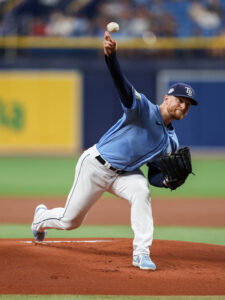It has been a middling start for the Giants, who fell to 16-20 with a loss to the Nationals this evening. San Francisco’s lineup has been a mediocre group overall, largely thanks to slow starts from Michael Conforto, David Villar and Brandon Crawford.
Despite the bland overall results, the Giants are getting strong contributions from a handful of players acquired in minor trades. LaMonte Wade Jr., J.D. Davis and Mike Yastrzemski all landed in the organization via small or buy-low deals. That’s also true of the player who has been arguably the team’s most valuable contributor in 2023: middle infielder Thairo Estrada.
Estrada began his professional career a little more than a decade ago. He signed with the Yankees as an amateur out of Venezuela. While he was never an elite prospect, the 5’10” infielder appeared among the organization’s top 30 minor league talents at Baseball America every year between 2014-19. Estrada had been an effective hitter up through Double-A but he lost the bulk of the 2018 season after being shot in the leg during a robbery attempt the preceding offseason. He required a pair of surgeries, and while he returned to play the majority of the ’19 campaign, his offensive numbers in Triple-A dropped.
The Yankees played Estrada sparingly at the big league level between 2019-20. Relegated to a depth role on a roster with DJ LeMahieu, Gio Urshela and Gleyber Torres, he appeared in 61 games in pinstripes. New York designated him for assignment during the first week of the 2021 season upon trading for Rougned Odor to serve as a depth infielder. The Giants jumped the waiver order, acquiring Estrada for cash five days later.
Getting any kind of contributions from a player added for that kind of minimal cost would have counted as a win. Estrada has far exceeded what the Giants themselves likely had anticipated. He was on and off the active roster in 2021, hitting .273/.333/.479 in 52 big league contests. By last season, he’d established himself as the primary second baseman. Estrada held that job with another above-average showing, putting together a .260/.322/.400 line with 14 home runs and 21 stolen bases through a personal-high 541 plate appearances.
San Francisco tabbed Estrada as its Opening Day second baseman for a second consecutive season. He’s responded with a torrid start, carrying a .338/.388/.522 slash over 38 games. He’s already connected on six home runs and seven doubles, and he’s swiped 10 bags in 12 attempts. Estrada has split his defensive work almost evenly between the two middle infield spots, moving to shortstop lately after Crawford hit the injured list. Public metrics suggest he’s better suited for second base, where he figures to return once Crawford is healthy.
Estrada isn’t going to keep hitting at this pace. He’s running a .396 batting average on balls in play in spite of a modest 31.8% hard contact rate. As a few more batted balls find gloves, his offense will take a step back. Even with some regression, Estrada looks to have established himself as a slightly above-average hitter. He’s now up to 820 plate appearances of .277/.336/.435 batting since landing in San Francisco. He puts the ball in play to compensate for middling walk totals and has solid if unexceptional power.
Combine that offense with quality baserunning and the ability to play up the middle and Estrada looks like a well-rounded everyday option who’s currently playing at an All-Star level. The Giants have already gotten far more out of Estrada than teams get in the vast majority of transactions for players who’d been in DFA limbo.
He’s likely to remain a contributor — albeit not quite at his early-season level — for the next few seasons. Estrada is making just $2.25MM in his first of four years of arbitration eligibility. The Giants can keep him around via that process through 2026. It’s rare for teams to retain players whom they’d added in a cash transaction for multiple seasons but Estrada has played his way into an important role in the Bay Area.



